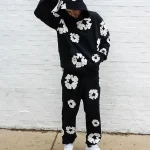
In recent years, Germany has emerged as an unexpected epicenter of cultural transformation in fashion, embracing apparel that speaks not just to style, but to identity, heritage, and social consciousness. At the forefront of this movement is Denim Tears, a brand founded by Tremaine Emory, known for its bold storytelling and unapologetic representation of Black culture and history. What began as a niche label in the United States has now transcended borders, finding a deep and meaningful resonance denim tears within German youth culture, streetwear communities, and artistic circles. The German fashion landscape, once defined primarily by minimalist aesthetics and functional design, is entering a new era—one where apparel is not only worn, but experienced as a cultural statement.
The Cultural Shift in German Fashion
Germany has long been recognized for its structured and utilitarian approach to clothing. From the industrial influence on workwear to the clean lines of Berlin’s fashion week showcases, the country’s sartorial identity was often rooted in subtlety. However, globalization and digital connectivity have transformed fashion from a local industry into a global conversation. Young consumers in Germany are no longer satisfied with clothing that merely looks good; they seek garments that tell stories, provoke thought, and communicate their values.
This is where Denim Tears enters the picture. Far more than just a fashion label, Denim Tears is a cultural force. Each collection serves as a historical narrative, referencing the African diaspora, the cotton trade, and systemic injustices through symbolic designs such as cotton wreath motifs and thought-provoking slogans. For German consumers, especially those passionate about social justice and cultural awareness, Denim Tears offers authenticity in an era where fashion can often feel commercialized and detached from meaning.
Why Germany Connects Deeply with Denim Tears
The growing popularity of Denim Tears in Germany can be attributed to a cultural and generational shift. The younger generation is more politically aware and globally connected than ever before. Many are vocal about issues of colonial history, migration, and cultural identity—topics that Denim Tears confronts head-on. Germany, like many European countries, is actively engaged in national conversations about its own historical legacies and multicultural future. Through its apparel, Denim Tears presents a creative and reflective lens for these ongoing discussions.
Additionally, Germany’s thriving music and streetwear scenes have played a pivotal role in popularizing the brand. Hip-hop culture, which has been steadily rising in Germany, naturally aligns with Denim Tears’ artistic ethos. Influential German rappers, DJs, and visual artists have embraced the brand not just as a trend, but as a medium of cultural expression. This has cemented Denim Tears as a label that represents not only fashion, but a movement—a powerful blend of culture, identity, and resistance.
The Symbolism Behind Denim Tears’ Designs
One of the most distinctive features of Denim Tears is its use of symbolic imagery. The cotton wreath, one of its most recognized motifs, represents both the pain and resilience of Black history. In Germany, where discussions around colonialism and systemic racism are becoming increasingly visible, this symbolism speaks volumes. When German consumers wear Denim Tears, they are not merely adopting an international fashion brand; they are engaging in a global dialogue. The clothing becomes a form of wearable activism—a badge of awareness, education, and solidarity.
This symbolic power has resonated strongly with Germany’s diverse urban communities. Cities such as Berlin, Hamburg, and Frankfurt are now hubs for cultural exchange, where fashion is inseparable from music, art, and politics. In these cities, Denim Tears apparel is frequently spotted at gallery openings, underground concerts, and creative workshops, making it a visible representation of cultural unity and introspection.
Influencers and the Denim Tears Movement in Germany
The rise of Denim Tears in Germany has also been propelled by cultural influencers who serve as tastemakers for the new generation. These individuals are not conventional celebrities; they are activists, musicians, interdisciplinary artists, and cultural curators who use their platforms to challenge narratives and advocate for inclusivity. For them, wearing Denim Tears is not an act of trend-following, but a declaration of values. Their influence extends beyond fashion into the realms of societal change and empowerment.
German influencers have embraced Denim Tears as part of a larger narrative of identity reclamation and global solidarity. By promoting the brand on social media and featuring it in artistic collaborations, they are helping shape a fashion ecosystem where apparel serves as a form of storytelling. This has not only increased the brand’s visibility but cemented its role in a broader cultural awakening in Germany.
The Role of German Youth in the Denim Tears Phenomenon
To understand the Denim Tears movement in Germany, one must look to the driving force behind it: the youth. This generation is defined by its desire to challenge norms, question history, and advocate for justice. They are not passive consumers but active participants in shaping culture. Denim Tears aligns perfectly with this mindset by offering a platform for expression. Through its designs, young Germans are able to visually articulate their awareness of global issues, their stance on human rights, and their appreciation for cultural diversity.
The acceptance of Denim Tears by Germany’s youth is also indicative of a larger shift in how fashion is perceived. No longer is clothing seen as a tool for individual expression alone; it is now recognized as a medium for collective identity. Wearing Denim Tears signifies belonging to a community that values consciousness over conformity and storytelling over superficial aesthetics.
Denim Tears and the Evolution of Global Fashion
Germany’s embrace of Denim Tears reflects a wider transformation in the global fashion industry. Brands are increasingly expected to be transparent, purposeful, and culturally engaged. Consumers are no longer Denim Tears T-Shirt content with surface-level style; they demand authenticity. Denim Tears sets a precedent for what future fashion brands must aspire to: meaningful creation with a clear voice and vision.
As Germany integrates Denim Tears into its cultural fabric, it highlights an important truth about modern fashion—it is no longer just about what we wear, but why we wear it. Fashion has become a powerful language for social dialogue, and Germany is emerging as one of its most eloquent speakers.
Conclusion: A New Era of Cultural Apparel in Germany
Germany’s relationship with Denim Tears signifies more than the rise of a new fashion trend. It marks a profound cultural shift, one that embraces apparel as a form of storytelling, activism, and global connection. Denim Tears has been welcomed in Germany not just because of its distinctive style, but because it resonates with a generation seeking deeper meaning and authenticity in everything they wear.
As the brand continues to grow in popularity, it is clear that Germany is not merely consuming Denim Tears—it is embodying its message. This new era of cultural apparel represents a merging of history and modernity, art and activism, identity and expression. In embracing Denim Tears, Germany is carving out a bold and inclusive future for fashion—one where clothing speaks, and the world listens.




